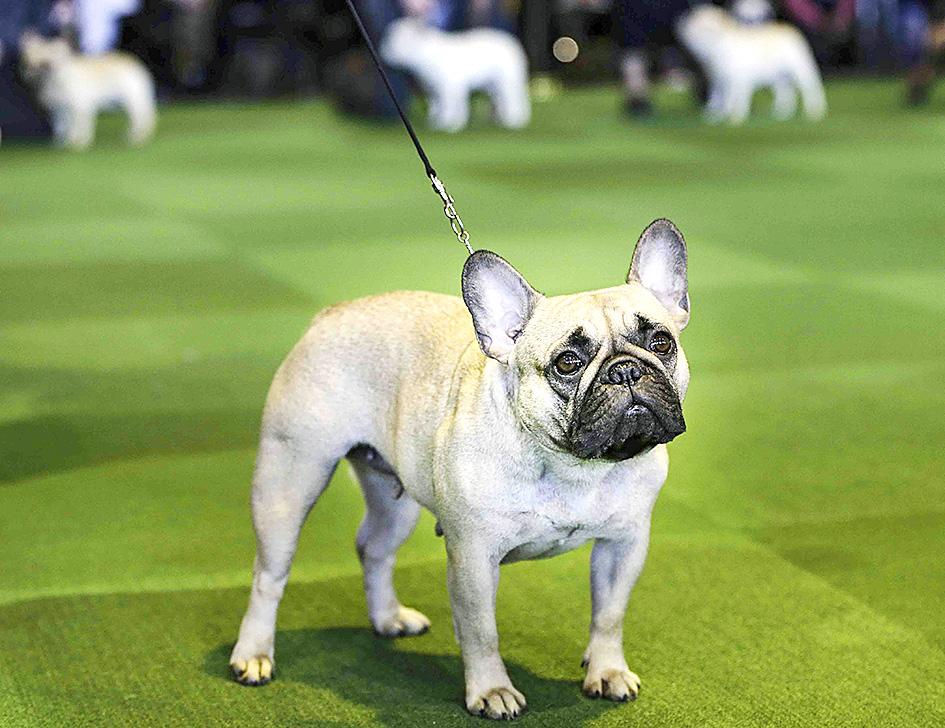Could the French bulldog become America’s favorite purebred pooch?
After riding a rocket ship to popularity over the last quarter-century, Frenchies came in second only to Labrador retrievers — the leaders for 30 straight years — in the American Kennel Club’s (AKC) latest rankings, which was released Wednesday. They reflect the relative numbers of purebreds, mainly puppies, that were added last year to the oldest US dog registry.
Stocky and smush-faced, French bulldogs have their charms — at least in fans’ eyes — but also their limitations.

Photo: Reuters
“They’re not the type of dog to go hiking with you,” AKC spokesperson Brandi Hunter says, “but if you want a dog that’s going to snuggle up with you, be cute, be adaptable, minimal grooming... that’s the kind of breed for you.”
A dig into the details:
‧ THE TOP 10

Photo: AP
After Labrador retrievers and French bulldogs, the top 10 breeds include German shepherds, golden retrievers, bulldogs, poodles, beagles, Rottweilers and German shorthaired pointers. Dachshunds made the top 10 for the first time since 2013.
Prized as easygoing and can-do dogs, Labs years ago broke the record for the longest number-one run, and they remain most popular by a lot. More than 98,300 Labs joined the AKC’s registry last year, compared to about 66,500 French bulldogs.
German shepherds are enjoying their own form of doggie leadership, however. President Joe Biden’s shepherds, Champ and Major, have been living in the White House, though they were recently sent back to Biden’s Delaware home for a canine cooling-off period after Major injured a Secret Service agent.
The poodle may also make a claim to the top-dog crown: A standard poodle named Siba was the most recent winner of the prestigious Westminster Kennel Club dog show, held last year.
Breeds on the move include the cane corso, a heavy-duty guard dog that broke into the top 25. It was 51st just a decade ago.
‧ VIVE LA FRENCHIE
When Labrador retrievers first topped the chart in 1991, French bulldogs ranked a distant 82nd. But Frenchies began to rise in the rankings in the late ‘90s, hitting No 4 by 2017.
Celebrity owners from Martha Stewart to Lady Gaga to Dwayne “The Rock” Johnson have given the breed exposure. And its compact size, moderate exercise needs, no-fuss coat and rather comic demeanor struck a chord with many dog seekers.
“They are snoring, farting little love machines,” says Nicole Denny, a professional dog handler who has been breeding French bulldogs for 15 years after 20 years with Doberman pinschers.
She sees Frenchies’ popularity surge as “a blessing and a curse.”
“I would feel selfish, in a way, if other people didn’t get to enjoy the breed because they are just so wonderful,” says Denny, of Pleasant Plain, Ohio. But “it’s brought about a lot of people who aren’t breeding wisely.”
French bulldog fanciers need to be aware that the breed can be prone to overheating, breathing difficulties and back problems. Other breeds also are susceptible to various conditions, and mixed-breeds aren’t necessarily free of them, notes the AKC’s chief veterinary officer, Jerry Klein.
“There’s no dog, whether it’s purebred or mixed-breed, that is 100 percent guaranteed to be completely without problems,” he said. “You should know what you’re getting and know the possibilities.”
‧ WHO’S IN, WHO’S OUT AND WHO’S NEW
The popularity rankings are limited to the more than 190 breeds recognized by the AKC — no doodles or other “designer” hybrids, not to mention everyday mixes and mutts.
New to the list are two breeds that got recognized last year: the dogo Argentino, joining the popularity rankings in 93rd place — notable for a newcomer — and the barbet, at 145th.
The rarest breed is the Norwegian lundehund. The modest-sized, nimble dogs might be little-known in the US but have intriguing distinctions, including six-toed feet, unusual flexibility, climbing acumen and a history of hunting puffins.
‧ THE DEBATE OVER DOG BREEDING
Animal-rights advocates complain that interest in purebred dogs fuels puppy mills and leaves other pooches stuck in shelters. The AKC counters that conscientious breeding produces dogs adept at such work such as bomb-sniffing, and enables pet owners to choose a breed suited to the activities — or lack thereof — that they have in mind.
Still, the AKC rues that pup-ularity sometimes spurs people to acquire a breed they haven’t researched.
“Don’t let the popularity drive the decision,” Hunter said. “Let your lifestyle drive the decision.”

On April 26, The Lancet published a letter from two doctors at Taichung-based China Medical University Hospital (CMUH) warning that “Taiwan’s Health Care System is on the Brink of Collapse.” The authors said that “Years of policy inaction and mismanagement of resources have led to the National Health Insurance system operating under unsustainable conditions.” The pushback was immediate. Errors in the paper were quickly identified and publicized, to discredit the authors (the hospital apologized). CNA reported that CMUH said the letter described Taiwan in 2021 as having 62 nurses per 10,000 people, when the correct number was 78 nurses per 10,000

As we live longer, our risk of cognitive impairment is increasing. How can we delay the onset of symptoms? Do we have to give up every indulgence or can small changes make a difference? We asked neurologists for tips on how to keep our brains healthy for life. TAKE CARE OF YOUR HEALTH “All of the sensible things that apply to bodily health apply to brain health,” says Suzanne O’Sullivan, a consultant in neurology at the National Hospital for Neurology and Neurosurgery in London, and the author of The Age of Diagnosis. “When you’re 20, you can get away with absolute

When the South Vietnamese capital of Saigon fell to the North Vietnamese forces 50 years ago this week, it prompted a mass exodus of some 2 million people — hundreds of thousands fleeing perilously on small boats across open water to escape the communist regime. Many ultimately settled in Southern California’s Orange County in an area now known as “Little Saigon,” not far from Marine Corps Base Camp Pendleton, where the first refugees were airlifted upon reaching the US. The diaspora now also has significant populations in Virginia, Texas and Washington state, as well as in countries including France and Australia.

May 5 to May 11 What started out as friction between Taiwanese students at Taichung First High School and a Japanese head cook escalated dramatically over the first two weeks of May 1927. It began on April 30 when the cook’s wife knew that lotus starch used in that night’s dinner had rat feces in it, but failed to inform staff until the meal was already prepared. The students believed that her silence was intentional, and filed a complaint. The school’s Japanese administrators sided with the cook’s family, dismissing the students as troublemakers and clamping down on their freedoms — with